Evaluating the Impacts of BIM Technologies on Construction Practices
VerifiedAdded on 2023/06/03
|11
|2623
|248
Report
AI Summary
This report provides a comprehensive analysis of the impacts of Building Information Modeling (BIM) technologies on construction practices. It begins by defining BIM and its role in coordinating various processes like designing, planning, and analyzing in architecture, construction, and engineering fields. The report discusses how BIM technologies revolutionize the construction industry by improving design development, cost estimation, and construction management. A case study of the Hohhot City Saihan District National Fitness Center project illustrates the practical application and benefits of BIM. Furthermore, the report highlights the positive impacts of BIM, such as enhanced collaboration, accurate cost estimation, and improved visualization, while also addressing limitations like compatibility issues and implementation costs. The conclusion emphasizes BIM's potential to enhance construction company performance, despite challenges in widespread adoption, and advocates for its continued integration in the industry.
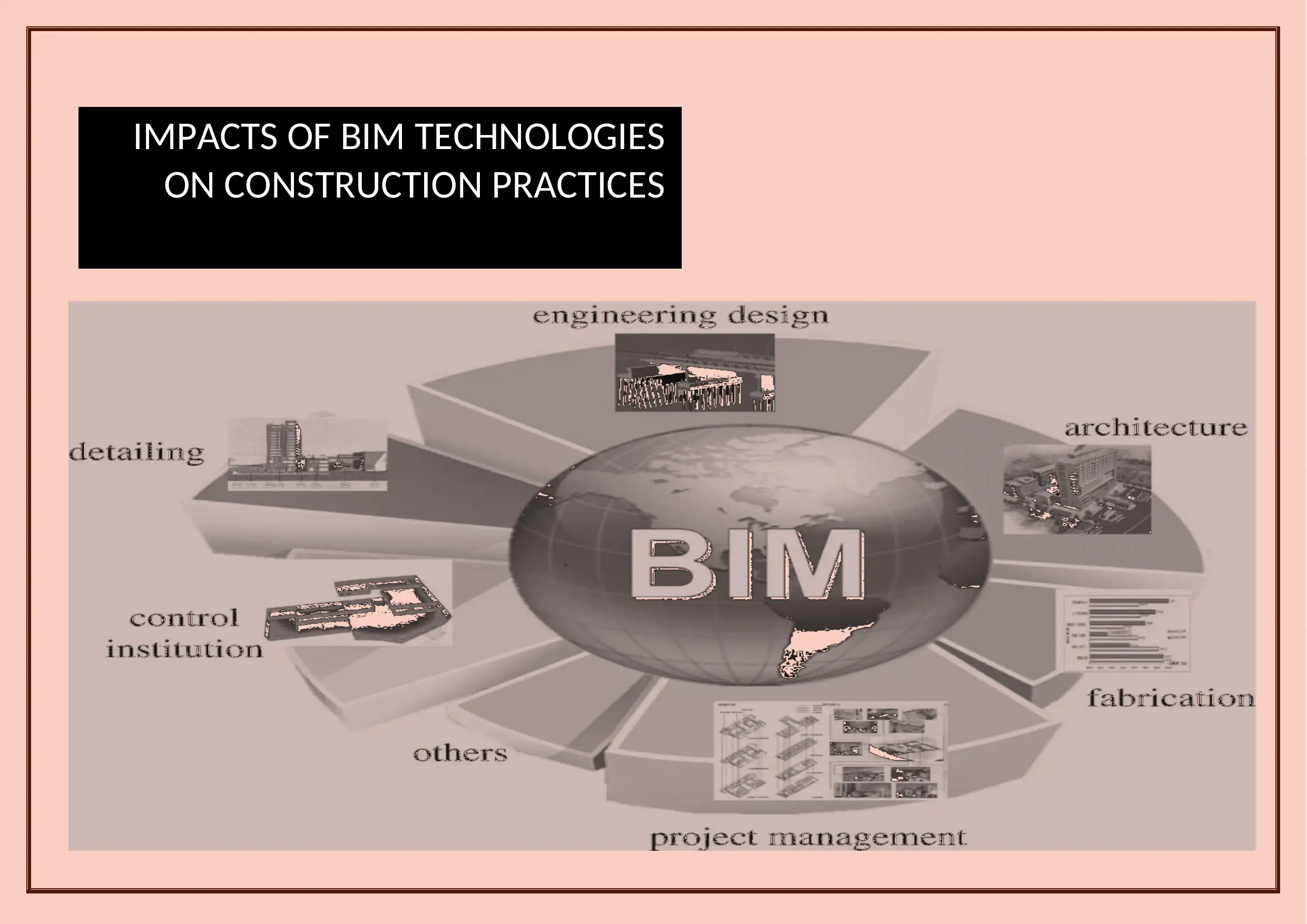
IMPACTS OF BIM TECHNOLOGIES
ON CONSTRUCTION PRACTICES
ON CONSTRUCTION PRACTICES
Paraphrase This Document
Need a fresh take? Get an instant paraphrase of this document with our AI Paraphraser
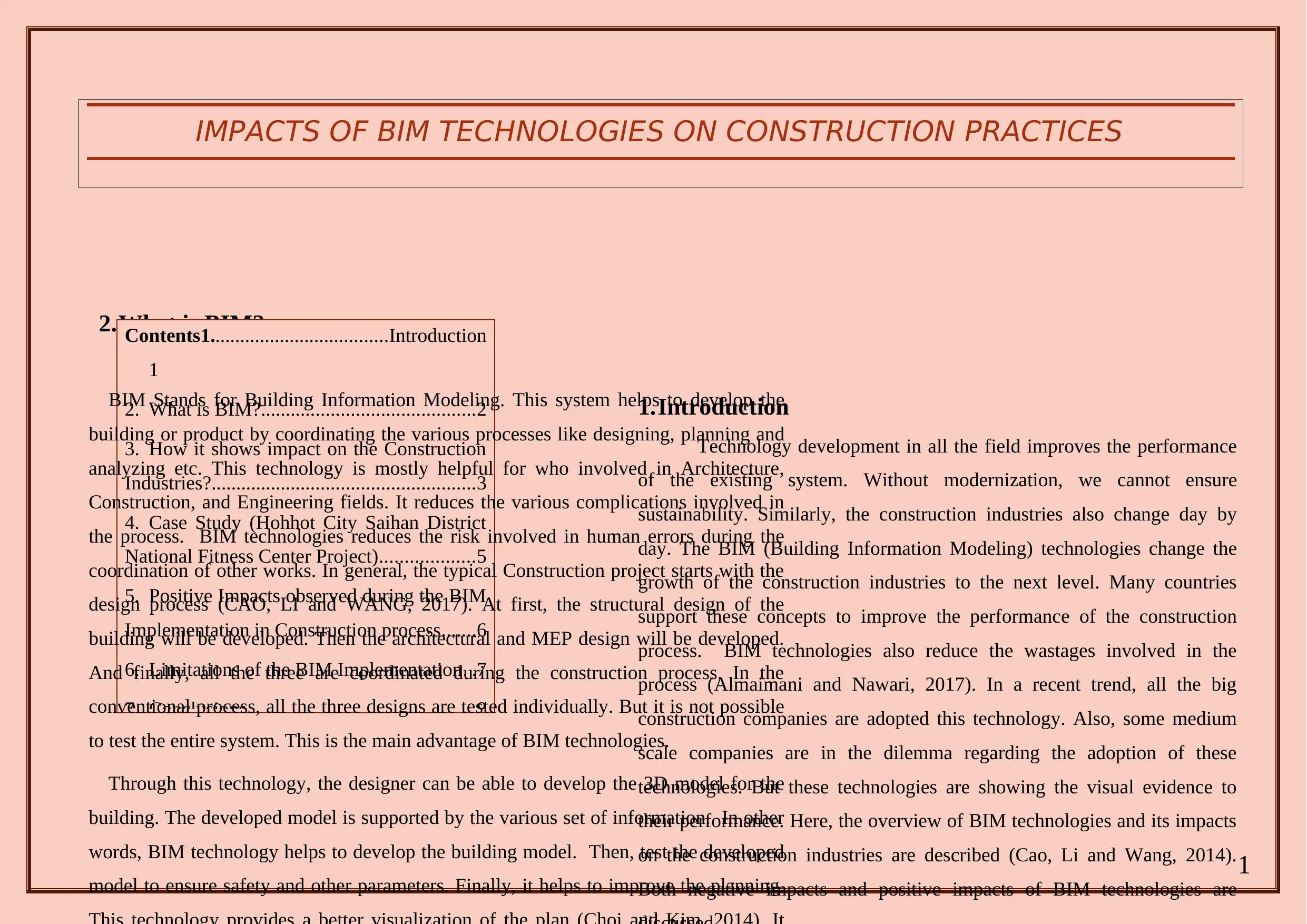
1
2.What is BIM?
IMPACTS OF BIM TECHNOLOGIES ON CONSTRUCTION PRACTICES
1.Introduction
Technology development in all the field improves the performance
of the existing system. Without modernization, we cannot ensure
sustainability. Similarly, the construction industries also change day by
day. The BIM (Building Information Modeling) technologies change the
growth of the construction industries to the next level. Many countries
support these concepts to improve the performance of the construction
process. BIM technologies also reduce the wastages involved in the
process (Almaimani and Nawari, 2017). In a recent trend, all the big
construction companies are adopted this technology. Also, some medium
scale companies are in the dilemma regarding the adoption of these
technologies. But these technologies are showing the visual evidence to
their performance. Here, the overview of BIM technologies and its impacts
on the construction industries are described (Cao, Li and Wang, 2014).
Both negative impacts and positive impacts of BIM technologies are
Contents1....................................Introduction
1
2. What is BIM?...........................................2
3. How it shows impact on the Construction
Industries?.....................................................3
4. Case Study (Hohhot City Saihan District
National Fitness Center Project)...................5
5. Positive Impacts observed during the BIM
Implementation in Construction process.......6
6. Limitations of the BIM Implementation. .7
7. Conclusions..............................................8
BIM Stands for Building Information Modeling. This system helps to develop the
building or product by coordinating the various processes like designing, planning and
analyzing etc. This technology is mostly helpful for who involved in Architecture,
Construction, and Engineering fields. It reduces the various complications involved in
the process. BIM technologies reduces the risk involved in human errors during the
coordination of other works. In general, the typical Construction project starts with the
design process (CAO, LI and WANG, 2017). At first, the structural design of the
building will be developed. Then the architectural and MEP design will be developed.
And finally, all the three are coordinated during the construction process. In the
conventional process, all the three designs are tested individually. But it is not possible
to test the entire system. This is the main advantage of BIM technologies.
Through this technology, the designer can be able to develop the 3D model for the
building. The developed model is supported by the various set of information. In other
words, BIM technology helps to develop the building model. Then, test the developed
model to ensure safety and other parameters. Finally, it helps to improve the planning.
2.What is BIM?
IMPACTS OF BIM TECHNOLOGIES ON CONSTRUCTION PRACTICES
1.Introduction
Technology development in all the field improves the performance
of the existing system. Without modernization, we cannot ensure
sustainability. Similarly, the construction industries also change day by
day. The BIM (Building Information Modeling) technologies change the
growth of the construction industries to the next level. Many countries
support these concepts to improve the performance of the construction
process. BIM technologies also reduce the wastages involved in the
process (Almaimani and Nawari, 2017). In a recent trend, all the big
construction companies are adopted this technology. Also, some medium
scale companies are in the dilemma regarding the adoption of these
technologies. But these technologies are showing the visual evidence to
their performance. Here, the overview of BIM technologies and its impacts
on the construction industries are described (Cao, Li and Wang, 2014).
Both negative impacts and positive impacts of BIM technologies are
Contents1....................................Introduction
1
2. What is BIM?...........................................2
3. How it shows impact on the Construction
Industries?.....................................................3
4. Case Study (Hohhot City Saihan District
National Fitness Center Project)...................5
5. Positive Impacts observed during the BIM
Implementation in Construction process.......6
6. Limitations of the BIM Implementation. .7
7. Conclusions..............................................8
BIM Stands for Building Information Modeling. This system helps to develop the
building or product by coordinating the various processes like designing, planning and
analyzing etc. This technology is mostly helpful for who involved in Architecture,
Construction, and Engineering fields. It reduces the various complications involved in
the process. BIM technologies reduces the risk involved in human errors during the
coordination of other works. In general, the typical Construction project starts with the
design process (CAO, LI and WANG, 2017). At first, the structural design of the
building will be developed. Then the architectural and MEP design will be developed.
And finally, all the three are coordinated during the construction process. In the
conventional process, all the three designs are tested individually. But it is not possible
to test the entire system. This is the main advantage of BIM technologies.
Through this technology, the designer can be able to develop the 3D model for the
building. The developed model is supported by the various set of information. In other
words, BIM technology helps to develop the building model. Then, test the developed
model to ensure safety and other parameters. Finally, it helps to improve the planning.

2
Figure 1 BIM
Figure 1 BIM
⊘ This is a preview!⊘
Do you want full access?
Subscribe today to unlock all pages.

Trusted by 1+ million students worldwide
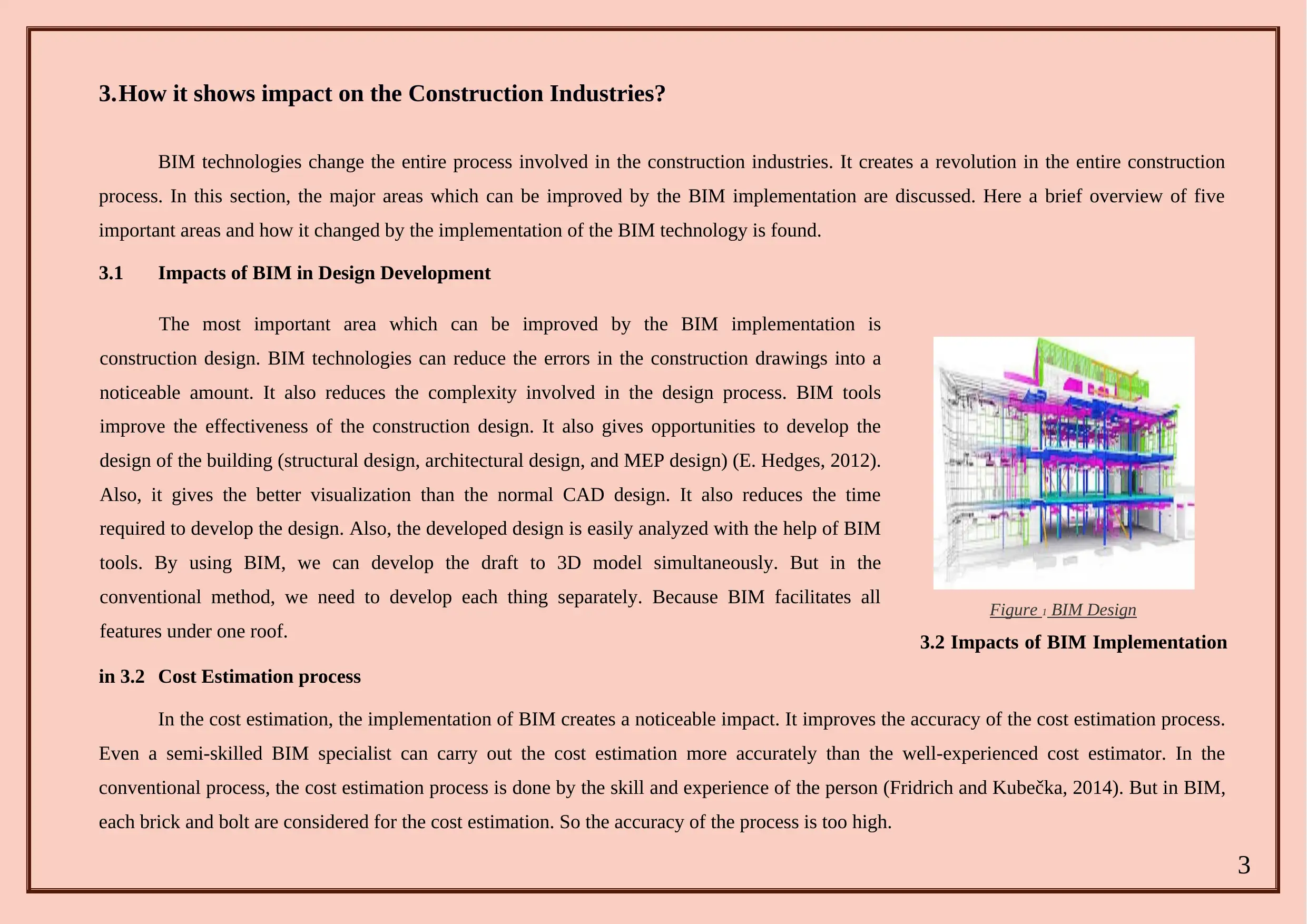
3
3.How it shows impact on the Construction Industries?
BIM technologies change the entire process involved in the construction industries. It creates a revolution in the entire construction
process. In this section, the major areas which can be improved by the BIM implementation are discussed. Here a brief overview of five
important areas and how it changed by the implementation of the BIM technology is found.
3.1 Impacts of BIM in Design Development
Figure 1 BIM Design
3.2 Impacts of BIM Implementation
in 3.2 Cost Estimation process
In the cost estimation, the implementation of BIM creates a noticeable impact. It improves the accuracy of the cost estimation process.
Even a semi-skilled BIM specialist can carry out the cost estimation more accurately than the well-experienced cost estimator. In the
conventional process, the cost estimation process is done by the skill and experience of the person (Fridrich and Kubečka, 2014). But in BIM,
each brick and bolt are considered for the cost estimation. So the accuracy of the process is too high.
The most important area which can be improved by the BIM implementation is
construction design. BIM technologies can reduce the errors in the construction drawings into a
noticeable amount. It also reduces the complexity involved in the design process. BIM tools
improve the effectiveness of the construction design. It also gives opportunities to develop the
design of the building (structural design, architectural design, and MEP design) (E. Hedges, 2012).
Also, it gives the better visualization than the normal CAD design. It also reduces the time
required to develop the design. Also, the developed design is easily analyzed with the help of BIM
tools. By using BIM, we can develop the draft to 3D model simultaneously. But in the
conventional method, we need to develop each thing separately. Because BIM facilitates all
features under one roof.
3.How it shows impact on the Construction Industries?
BIM technologies change the entire process involved in the construction industries. It creates a revolution in the entire construction
process. In this section, the major areas which can be improved by the BIM implementation are discussed. Here a brief overview of five
important areas and how it changed by the implementation of the BIM technology is found.
3.1 Impacts of BIM in Design Development
Figure 1 BIM Design
3.2 Impacts of BIM Implementation
in 3.2 Cost Estimation process
In the cost estimation, the implementation of BIM creates a noticeable impact. It improves the accuracy of the cost estimation process.
Even a semi-skilled BIM specialist can carry out the cost estimation more accurately than the well-experienced cost estimator. In the
conventional process, the cost estimation process is done by the skill and experience of the person (Fridrich and Kubečka, 2014). But in BIM,
each brick and bolt are considered for the cost estimation. So the accuracy of the process is too high.
The most important area which can be improved by the BIM implementation is
construction design. BIM technologies can reduce the errors in the construction drawings into a
noticeable amount. It also reduces the complexity involved in the design process. BIM tools
improve the effectiveness of the construction design. It also gives opportunities to develop the
design of the building (structural design, architectural design, and MEP design) (E. Hedges, 2012).
Also, it gives the better visualization than the normal CAD design. It also reduces the time
required to develop the design. Also, the developed design is easily analyzed with the help of BIM
tools. By using BIM, we can develop the draft to 3D model simultaneously. But in the
conventional method, we need to develop each thing separately. Because BIM facilitates all
features under one roof.
Paraphrase This Document
Need a fresh take? Get an instant paraphrase of this document with our AI Paraphraser
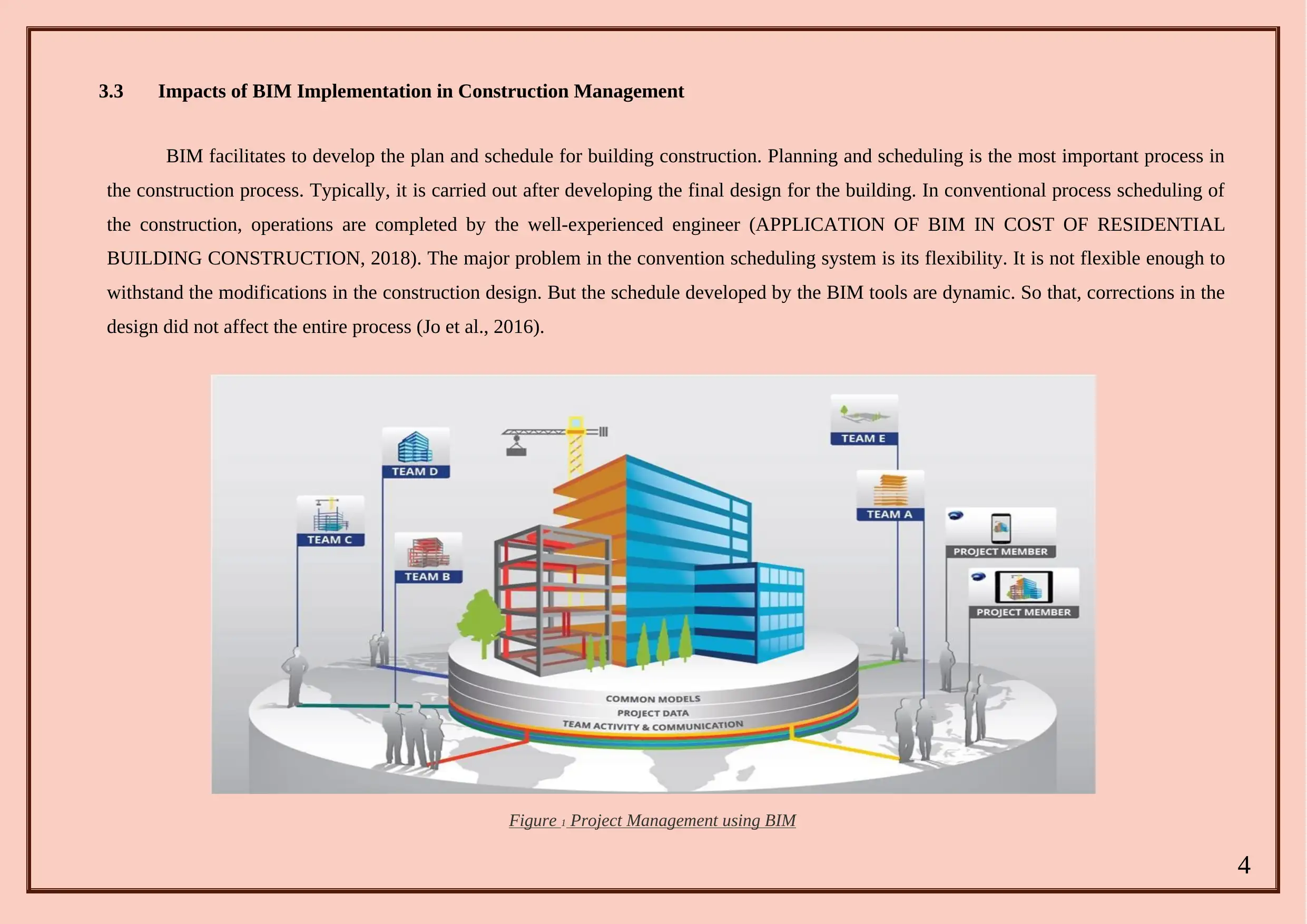
4
3.3 Impacts of BIM Implementation in Construction Management
Figure 1 Project Management using BIM
BIM facilitates to develop the plan and schedule for building construction. Planning and scheduling is the most important process in
the construction process. Typically, it is carried out after developing the final design for the building. In conventional process scheduling of
the construction, operations are completed by the well-experienced engineer (APPLICATION OF BIM IN COST OF RESIDENTIAL
BUILDING CONSTRUCTION, 2018). The major problem in the convention scheduling system is its flexibility. It is not flexible enough to
withstand the modifications in the construction design. But the schedule developed by the BIM tools are dynamic. So that, corrections in the
design did not affect the entire process (Jo et al., 2016).
3.3 Impacts of BIM Implementation in Construction Management
Figure 1 Project Management using BIM
BIM facilitates to develop the plan and schedule for building construction. Planning and scheduling is the most important process in
the construction process. Typically, it is carried out after developing the final design for the building. In conventional process scheduling of
the construction, operations are completed by the well-experienced engineer (APPLICATION OF BIM IN COST OF RESIDENTIAL
BUILDING CONSTRUCTION, 2018). The major problem in the convention scheduling system is its flexibility. It is not flexible enough to
withstand the modifications in the construction design. But the schedule developed by the BIM tools are dynamic. So that, corrections in the
design did not affect the entire process (Jo et al., 2016).

5
⊘ This is a preview!⊘
Do you want full access?
Subscribe today to unlock all pages.

Trusted by 1+ million students worldwide
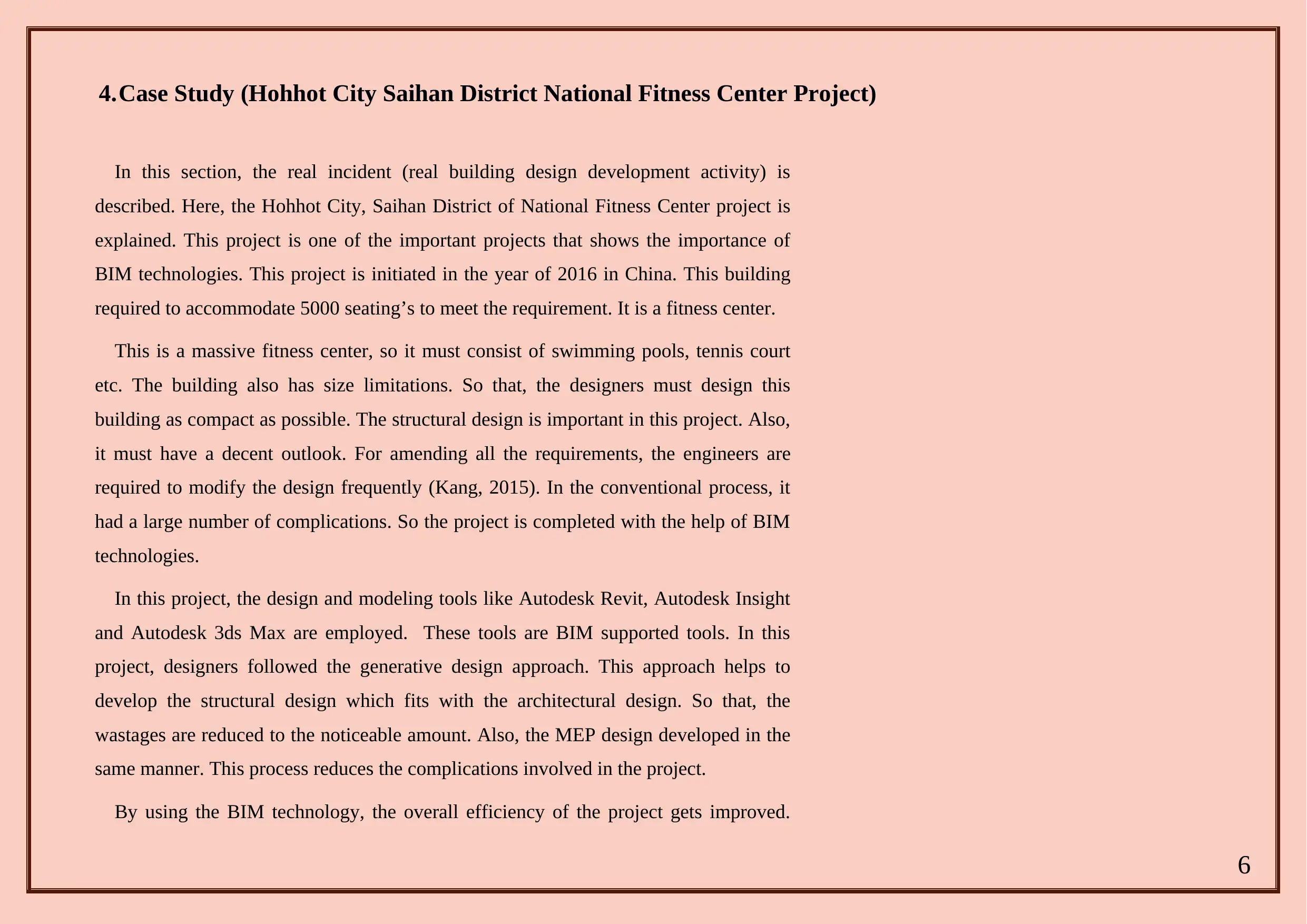
6
4.Case Study (Hohhot City Saihan District National Fitness Center Project)
In this section, the real incident (real building design development activity) is
described. Here, the Hohhot City, Saihan District of National Fitness Center project is
explained. This project is one of the important projects that shows the importance of
BIM technologies. This project is initiated in the year of 2016 in China. This building
required to accommodate 5000 seating’s to meet the requirement. It is a fitness center.
This is a massive fitness center, so it must consist of swimming pools, tennis court
etc. The building also has size limitations. So that, the designers must design this
building as compact as possible. The structural design is important in this project. Also,
it must have a decent outlook. For amending all the requirements, the engineers are
required to modify the design frequently (Kang, 2015). In the conventional process, it
had a large number of complications. So the project is completed with the help of BIM
technologies.
In this project, the design and modeling tools like Autodesk Revit, Autodesk Insight
and Autodesk 3ds Max are employed. These tools are BIM supported tools. In this
project, designers followed the generative design approach. This approach helps to
develop the structural design which fits with the architectural design. So that, the
wastages are reduced to the noticeable amount. Also, the MEP design developed in the
same manner. This process reduces the complications involved in the project.
By using the BIM technology, the overall efficiency of the project gets improved.
BIM technologies help to reduce the wastages effectively.
4.Case Study (Hohhot City Saihan District National Fitness Center Project)
In this section, the real incident (real building design development activity) is
described. Here, the Hohhot City, Saihan District of National Fitness Center project is
explained. This project is one of the important projects that shows the importance of
BIM technologies. This project is initiated in the year of 2016 in China. This building
required to accommodate 5000 seating’s to meet the requirement. It is a fitness center.
This is a massive fitness center, so it must consist of swimming pools, tennis court
etc. The building also has size limitations. So that, the designers must design this
building as compact as possible. The structural design is important in this project. Also,
it must have a decent outlook. For amending all the requirements, the engineers are
required to modify the design frequently (Kang, 2015). In the conventional process, it
had a large number of complications. So the project is completed with the help of BIM
technologies.
In this project, the design and modeling tools like Autodesk Revit, Autodesk Insight
and Autodesk 3ds Max are employed. These tools are BIM supported tools. In this
project, designers followed the generative design approach. This approach helps to
develop the structural design which fits with the architectural design. So that, the
wastages are reduced to the noticeable amount. Also, the MEP design developed in the
same manner. This process reduces the complications involved in the project.
By using the BIM technology, the overall efficiency of the project gets improved.
BIM technologies help to reduce the wastages effectively.
Paraphrase This Document
Need a fresh take? Get an instant paraphrase of this document with our AI Paraphraser
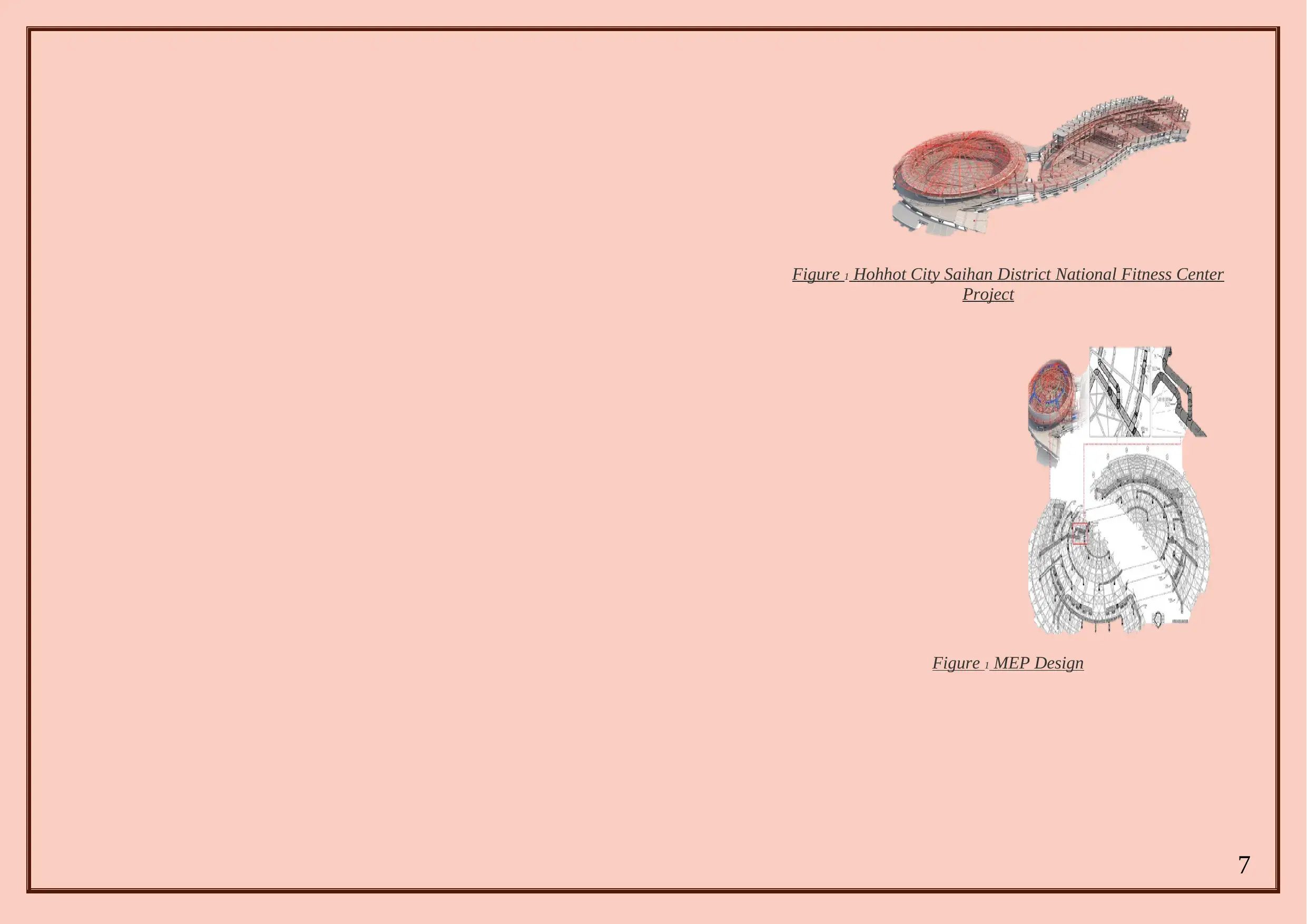
7
Figure 1 Hohhot City Saihan District National Fitness Center
Project
Figure 1 MEP Design
Figure 1 Hohhot City Saihan District National Fitness Center
Project
Figure 1 MEP Design
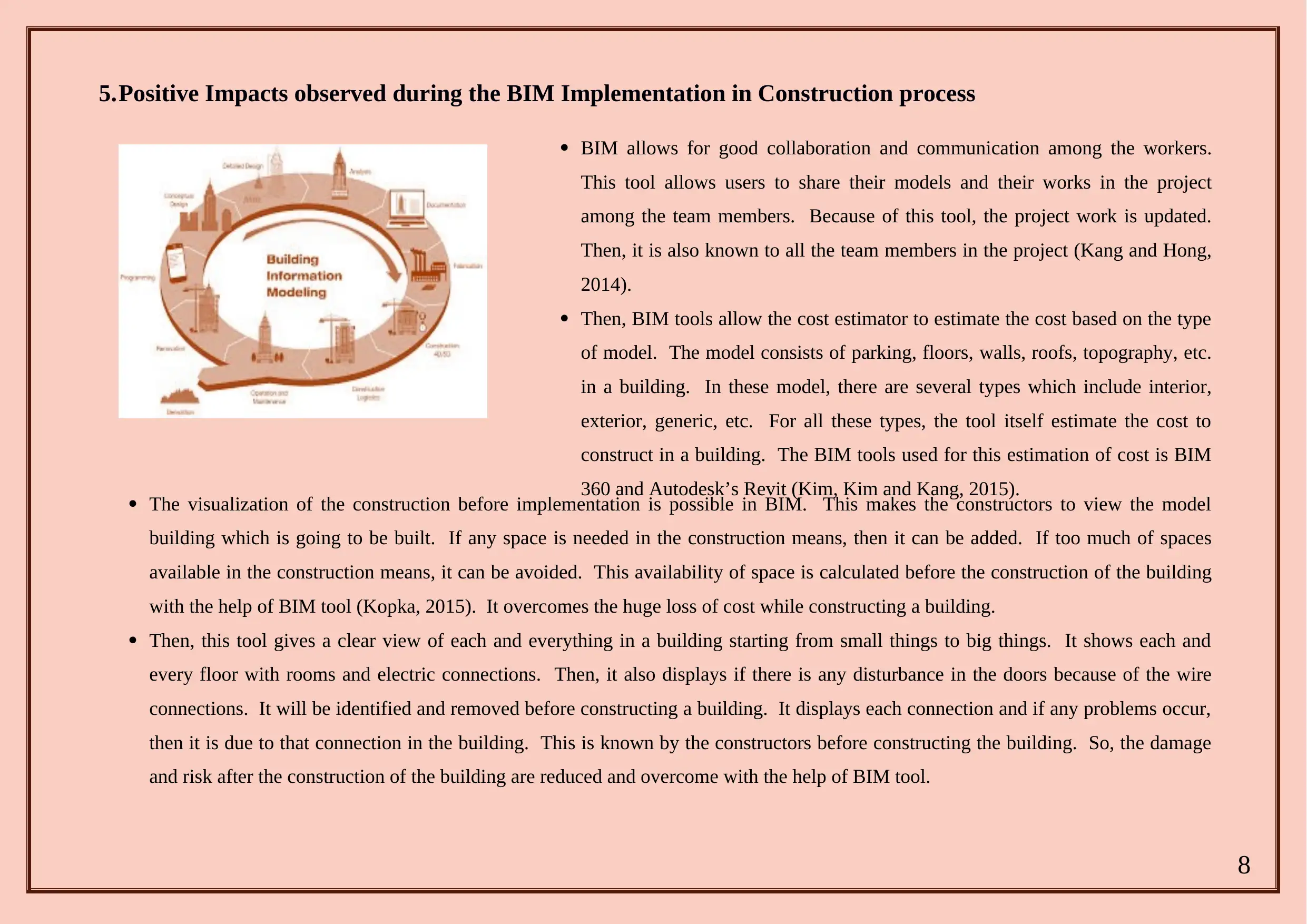
8
5.Positive Impacts observed during the BIM Implementation in Construction process
BIM allows for good collaboration and communication among the workers.
This tool allows users to share their models and their works in the project
among the team members. Because of this tool, the project work is updated.
Then, it is also known to all the team members in the project (Kang and Hong,
2014).
Then, BIM tools allow the cost estimator to estimate the cost based on the type
of model. The model consists of parking, floors, walls, roofs, topography, etc.
in a building. In these model, there are several types which include interior,
exterior, generic, etc. For all these types, the tool itself estimate the cost to
construct in a building. The BIM tools used for this estimation of cost is BIM
360 and Autodesk’s Revit (Kim, Kim and Kang, 2015).
The visualization of the construction before implementation is possible in BIM. This makes the constructors to view the model
building which is going to be built. If any space is needed in the construction means, then it can be added. If too much of spaces
available in the construction means, it can be avoided. This availability of space is calculated before the construction of the building
with the help of BIM tool (Kopka, 2015). It overcomes the huge loss of cost while constructing a building.
Then, this tool gives a clear view of each and everything in a building starting from small things to big things. It shows each and
every floor with rooms and electric connections. Then, it also displays if there is any disturbance in the doors because of the wire
connections. It will be identified and removed before constructing a building. It displays each connection and if any problems occur,
then it is due to that connection in the building. This is known by the constructors before constructing the building. So, the damage
and risk after the construction of the building are reduced and overcome with the help of BIM tool.
5.Positive Impacts observed during the BIM Implementation in Construction process
BIM allows for good collaboration and communication among the workers.
This tool allows users to share their models and their works in the project
among the team members. Because of this tool, the project work is updated.
Then, it is also known to all the team members in the project (Kang and Hong,
2014).
Then, BIM tools allow the cost estimator to estimate the cost based on the type
of model. The model consists of parking, floors, walls, roofs, topography, etc.
in a building. In these model, there are several types which include interior,
exterior, generic, etc. For all these types, the tool itself estimate the cost to
construct in a building. The BIM tools used for this estimation of cost is BIM
360 and Autodesk’s Revit (Kim, Kim and Kang, 2015).
The visualization of the construction before implementation is possible in BIM. This makes the constructors to view the model
building which is going to be built. If any space is needed in the construction means, then it can be added. If too much of spaces
available in the construction means, it can be avoided. This availability of space is calculated before the construction of the building
with the help of BIM tool (Kopka, 2015). It overcomes the huge loss of cost while constructing a building.
Then, this tool gives a clear view of each and everything in a building starting from small things to big things. It shows each and
every floor with rooms and electric connections. Then, it also displays if there is any disturbance in the doors because of the wire
connections. It will be identified and removed before constructing a building. It displays each connection and if any problems occur,
then it is due to that connection in the building. This is known by the constructors before constructing the building. So, the damage
and risk after the construction of the building are reduced and overcome with the help of BIM tool.
⊘ This is a preview!⊘
Do you want full access?
Subscribe today to unlock all pages.

Trusted by 1+ million students worldwide
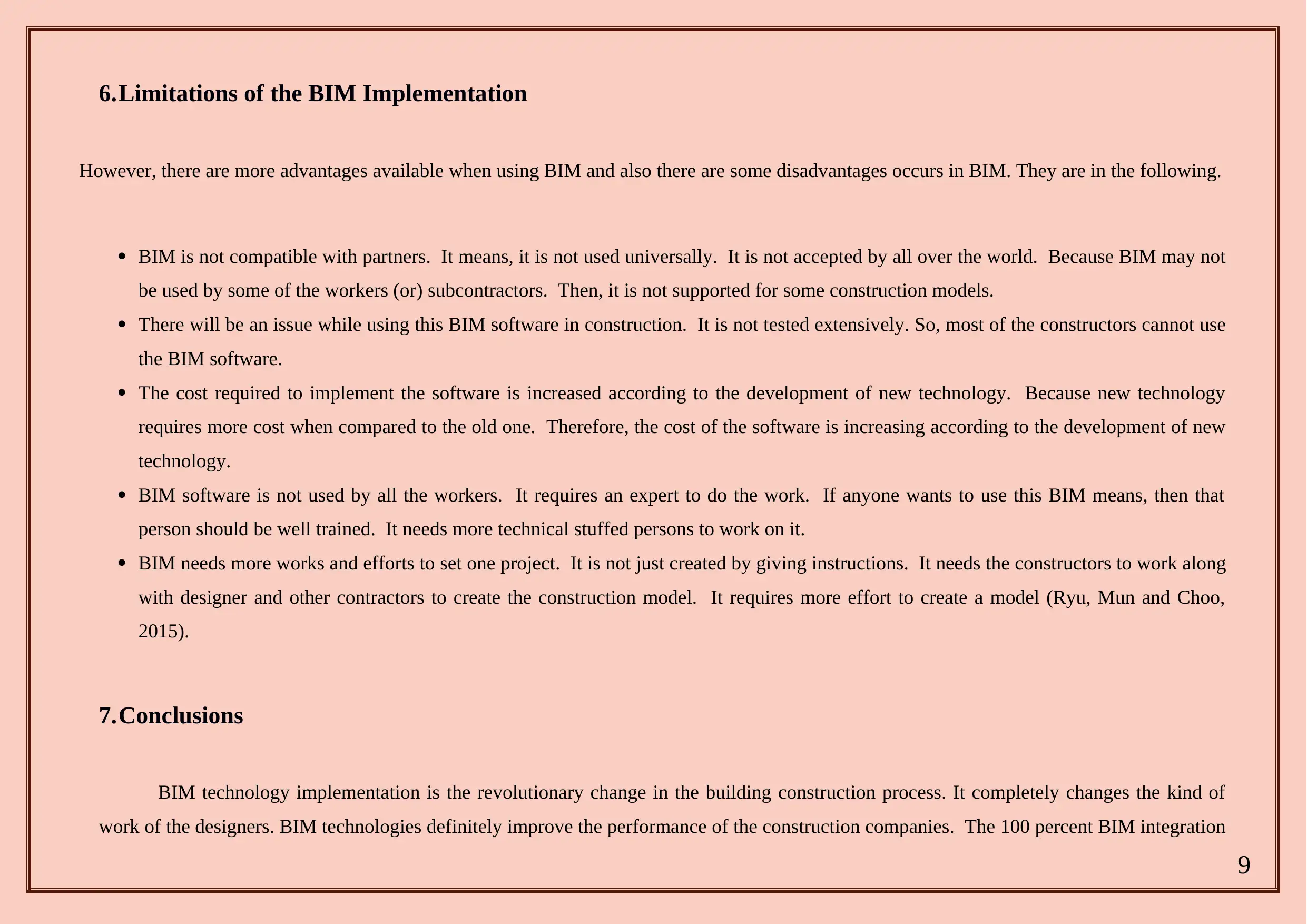
9
6.Limitations of the BIM Implementation
However, there are more advantages available when using BIM and also there are some disadvantages occurs in BIM. They are in the following.
BIM is not compatible with partners. It means, it is not used universally. It is not accepted by all over the world. Because BIM may not
be used by some of the workers (or) subcontractors. Then, it is not supported for some construction models.
There will be an issue while using this BIM software in construction. It is not tested extensively. So, most of the constructors cannot use
the BIM software.
The cost required to implement the software is increased according to the development of new technology. Because new technology
requires more cost when compared to the old one. Therefore, the cost of the software is increasing according to the development of new
technology.
BIM software is not used by all the workers. It requires an expert to do the work. If anyone wants to use this BIM means, then that
person should be well trained. It needs more technical stuffed persons to work on it.
BIM needs more works and efforts to set one project. It is not just created by giving instructions. It needs the constructors to work along
with designer and other contractors to create the construction model. It requires more effort to create a model (Ryu, Mun and Choo,
2015).
7.Conclusions
BIM technology implementation is the revolutionary change in the building construction process. It completely changes the kind of
work of the designers. BIM technologies definitely improve the performance of the construction companies. The 100 percent BIM integration
6.Limitations of the BIM Implementation
However, there are more advantages available when using BIM and also there are some disadvantages occurs in BIM. They are in the following.
BIM is not compatible with partners. It means, it is not used universally. It is not accepted by all over the world. Because BIM may not
be used by some of the workers (or) subcontractors. Then, it is not supported for some construction models.
There will be an issue while using this BIM software in construction. It is not tested extensively. So, most of the constructors cannot use
the BIM software.
The cost required to implement the software is increased according to the development of new technology. Because new technology
requires more cost when compared to the old one. Therefore, the cost of the software is increasing according to the development of new
technology.
BIM software is not used by all the workers. It requires an expert to do the work. If anyone wants to use this BIM means, then that
person should be well trained. It needs more technical stuffed persons to work on it.
BIM needs more works and efforts to set one project. It is not just created by giving instructions. It needs the constructors to work along
with designer and other contractors to create the construction model. It requires more effort to create a model (Ryu, Mun and Choo,
2015).
7.Conclusions
BIM technology implementation is the revolutionary change in the building construction process. It completely changes the kind of
work of the designers. BIM technologies definitely improve the performance of the construction companies. The 100 percent BIM integration
Paraphrase This Document
Need a fresh take? Get an instant paraphrase of this document with our AI Paraphraser
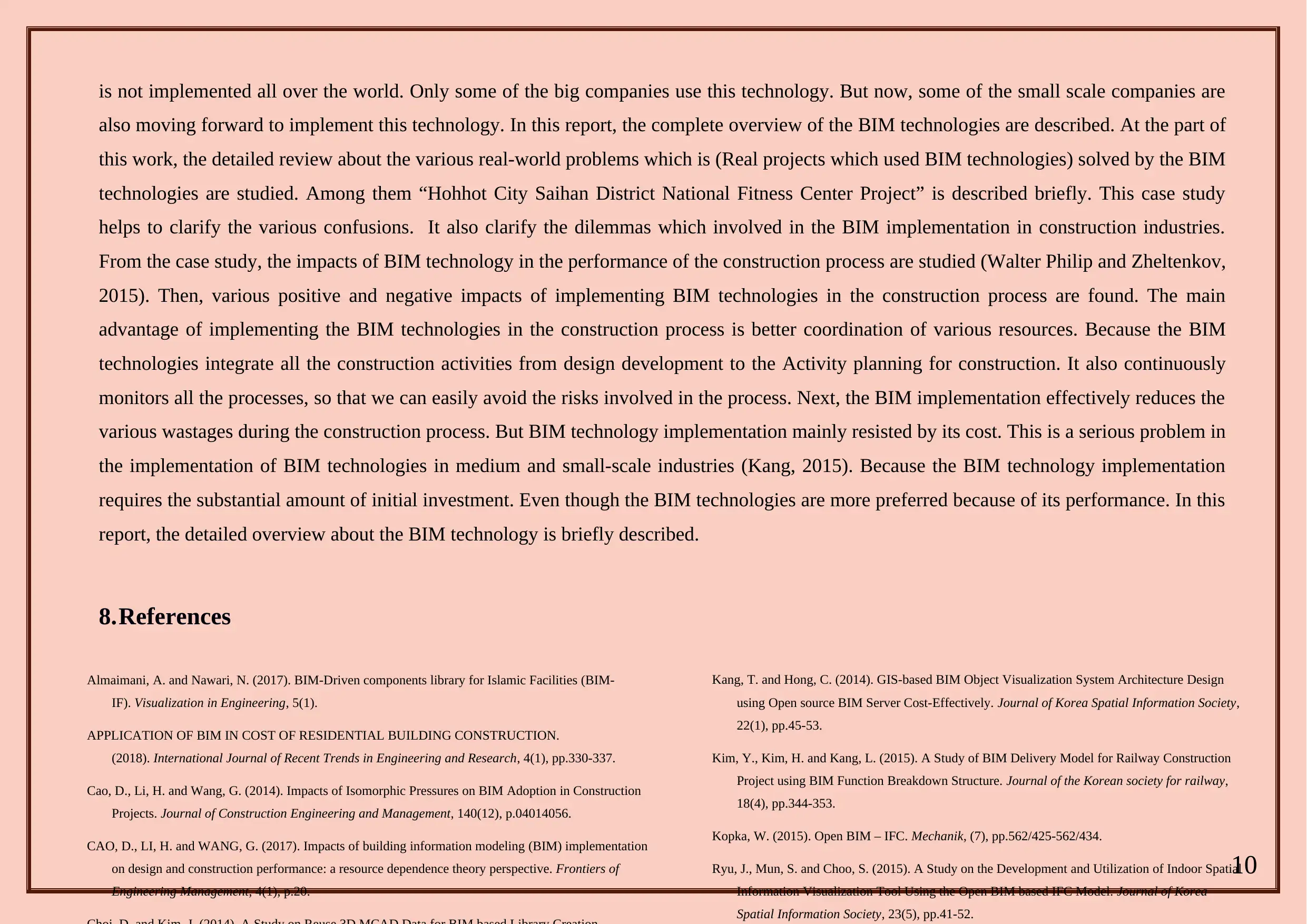
10
is not implemented all over the world. Only some of the big companies use this technology. But now, some of the small scale companies are
also moving forward to implement this technology. In this report, the complete overview of the BIM technologies are described. At the part of
this work, the detailed review about the various real-world problems which is (Real projects which used BIM technologies) solved by the BIM
technologies are studied. Among them “Hohhot City Saihan District National Fitness Center Project” is described briefly. This case study
helps to clarify the various confusions. It also clarify the dilemmas which involved in the BIM implementation in construction industries.
From the case study, the impacts of BIM technology in the performance of the construction process are studied (Walter Philip and Zheltenkov,
2015). Then, various positive and negative impacts of implementing BIM technologies in the construction process are found. The main
advantage of implementing the BIM technologies in the construction process is better coordination of various resources. Because the BIM
technologies integrate all the construction activities from design development to the Activity planning for construction. It also continuously
monitors all the processes, so that we can easily avoid the risks involved in the process. Next, the BIM implementation effectively reduces the
various wastages during the construction process. But BIM technology implementation mainly resisted by its cost. This is a serious problem in
the implementation of BIM technologies in medium and small-scale industries (Kang, 2015). Because the BIM technology implementation
requires the substantial amount of initial investment. Even though the BIM technologies are more preferred because of its performance. In this
report, the detailed overview about the BIM technology is briefly described.
8.References
Kang, T. and Hong, C. (2014). GIS-based BIM Object Visualization System Architecture Design
using Open source BIM Server Cost-Effectively. Journal of Korea Spatial Information Society,
22(1), pp.45-53.
Kim, Y., Kim, H. and Kang, L. (2015). A Study of BIM Delivery Model for Railway Construction
Project using BIM Function Breakdown Structure. Journal of the Korean society for railway,
18(4), pp.344-353.
Kopka, W. (2015). Open BIM – IFC. Mechanik, (7), pp.562/425-562/434.
Ryu, J., Mun, S. and Choo, S. (2015). A Study on the Development and Utilization of Indoor Spatial
Information Visualization Tool Using the Open BIM based IFC Model. Journal of Korea
Spatial Information Society, 23(5), pp.41-52.
Almaimani, A. and Nawari, N. (2017). BIM-Driven components library for Islamic Facilities (BIM-
IF). Visualization in Engineering, 5(1).
APPLICATION OF BIM IN COST OF RESIDENTIAL BUILDING CONSTRUCTION.
(2018). International Journal of Recent Trends in Engineering and Research, 4(1), pp.330-337.
Cao, D., Li, H. and Wang, G. (2014). Impacts of Isomorphic Pressures on BIM Adoption in Construction
Projects. Journal of Construction Engineering and Management, 140(12), p.04014056.
CAO, D., LI, H. and WANG, G. (2017). Impacts of building information modeling (BIM) implementation
on design and construction performance: a resource dependence theory perspective. Frontiers of
Engineering Management, 4(1), p.20.
is not implemented all over the world. Only some of the big companies use this technology. But now, some of the small scale companies are
also moving forward to implement this technology. In this report, the complete overview of the BIM technologies are described. At the part of
this work, the detailed review about the various real-world problems which is (Real projects which used BIM technologies) solved by the BIM
technologies are studied. Among them “Hohhot City Saihan District National Fitness Center Project” is described briefly. This case study
helps to clarify the various confusions. It also clarify the dilemmas which involved in the BIM implementation in construction industries.
From the case study, the impacts of BIM technology in the performance of the construction process are studied (Walter Philip and Zheltenkov,
2015). Then, various positive and negative impacts of implementing BIM technologies in the construction process are found. The main
advantage of implementing the BIM technologies in the construction process is better coordination of various resources. Because the BIM
technologies integrate all the construction activities from design development to the Activity planning for construction. It also continuously
monitors all the processes, so that we can easily avoid the risks involved in the process. Next, the BIM implementation effectively reduces the
various wastages during the construction process. But BIM technology implementation mainly resisted by its cost. This is a serious problem in
the implementation of BIM technologies in medium and small-scale industries (Kang, 2015). Because the BIM technology implementation
requires the substantial amount of initial investment. Even though the BIM technologies are more preferred because of its performance. In this
report, the detailed overview about the BIM technology is briefly described.
8.References
Kang, T. and Hong, C. (2014). GIS-based BIM Object Visualization System Architecture Design
using Open source BIM Server Cost-Effectively. Journal of Korea Spatial Information Society,
22(1), pp.45-53.
Kim, Y., Kim, H. and Kang, L. (2015). A Study of BIM Delivery Model for Railway Construction
Project using BIM Function Breakdown Structure. Journal of the Korean society for railway,
18(4), pp.344-353.
Kopka, W. (2015). Open BIM – IFC. Mechanik, (7), pp.562/425-562/434.
Ryu, J., Mun, S. and Choo, S. (2015). A Study on the Development and Utilization of Indoor Spatial
Information Visualization Tool Using the Open BIM based IFC Model. Journal of Korea
Spatial Information Society, 23(5), pp.41-52.
Almaimani, A. and Nawari, N. (2017). BIM-Driven components library for Islamic Facilities (BIM-
IF). Visualization in Engineering, 5(1).
APPLICATION OF BIM IN COST OF RESIDENTIAL BUILDING CONSTRUCTION.
(2018). International Journal of Recent Trends in Engineering and Research, 4(1), pp.330-337.
Cao, D., Li, H. and Wang, G. (2014). Impacts of Isomorphic Pressures on BIM Adoption in Construction
Projects. Journal of Construction Engineering and Management, 140(12), p.04014056.
CAO, D., LI, H. and WANG, G. (2017). Impacts of building information modeling (BIM) implementation
on design and construction performance: a resource dependence theory perspective. Frontiers of
Engineering Management, 4(1), p.20.
1 out of 11
Related Documents
Your All-in-One AI-Powered Toolkit for Academic Success.
+13062052269
info@desklib.com
Available 24*7 on WhatsApp / Email
![[object Object]](/_next/static/media/star-bottom.7253800d.svg)
Unlock your academic potential
Copyright © 2020–2025 A2Z Services. All Rights Reserved. Developed and managed by ZUCOL.




